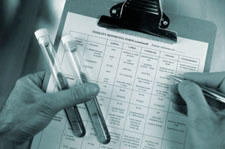The PSA Test - High PSA Levels and Prostate Cancer Diagnosis
The PSA test is most widely known as an indicator of prostate health. PSA levels are routinely monitored in men over 50. A High PSA level may result in a prostate cancer diagnosis.
The PSA (Prostate Specific Antigen) Test
A high PSA level is a sign that may indicate prostate cancer, and along with a tissue biopsy can result in a prostate cancer diagnosis.
This relates to antiaging because the tendency is for PSA levels to rise with advancing age. Thus experts recommend that men over 50 be tested yearly.
Antiaging in the sense that I am using it involves extending the healthy years of life for as long as possible. This involves preventing and detecting life threatening diseases before they can cut your life short, or otherwise create debilitating health conditions.
Prostate specific antigen is a protein that is created by the prostate gland, which normally does not get into the bloodstream. When it does, it indicates an abnormal condition of the prostate gland, which may or may not be cancerous.

A man with an elevated PSA level may have cancer, or may just have a condition called BPH (benign prostatic hypertrophy), which is a fancy way of saying an enlarged prostate, which might or might not the result of cancer.
How Is it Done?
The test is done using a blood sample drawn in a doctor’s office or clinic. The sample is then sent off to a test laboratory to be analyzed and interpreted. The doctor then discusses the PSA level and what the possible implications of it are.
It is very important that the results are discussed with a physician knowledgeable about the prostate and urinary system health such as a urologist or proctologist to ensure that your test is interpreted properly and that the correct course of action is followed.
The testing needs to be performed several times within a period of 18 months to get a more accurate reading. Several things can cause elevated PSA levels:
- Prostate cancer
- Absence of ejaculation in the previous 48 hours
- Urinary tract infection
- Inflammation
- BPH (benign prostatic enlargement)
- Age related increase in PSA
A doctor will often combine the results with a manual prostate exam (digital rectal exam) to feel for lumps or nodules on the prostate.
This is to get a more accurate idea of what is causing the elevated PSA levels, and what the likelihood of cancer is.
Free vs Total PSA
There are two forms of PSA that the cells of the prostate make. They are free PSA and protein bound PSA. The combination of these two forms makes up the total number that the PSA test is based upon.
Doctors are now using the ratio of free PSA to total as a more reliable indicator for the possibility of prostate cancer.

Another aspect that is considered is what is called PSA velocity, which is simply the rate at which the levels increase over time.
A sudden increase in PSA level is a stronger indicator of the likelihood of cancer than a gradual increase.
What Is Considered Good?
The following chart is from the National Institutes of Health:
- 0 to 2.5 ng/mL is low
- 2.6 to 10 ng/mL is slightly to moderately elevated
- 10 to 19.9 ng/mL is moderately elevated
- 20 ng/mL or more is significantly elevated
With regard to the possibility of prostate cancer, there are no safe levels, because cancer can exist in men who have very low levels, or may NOT exist in men with high levels.
The PSA test is not always a reliable indicator of prostate cancer or the risk of prostate cancer in individual cases. At best, the PSA level is a red flag that warrants attention from your health practitioner.
There is a new screening procedure for more accurate detection of prostate cancer on the horizon called the early prostate cancer antigen-2 (EPCA-2). This has been developed by researchers at John Hopkins and will likely replace the PSA in the near future.
If Your PSA Level is High
If the results are high, then your doctor will perform a manual prostate exam, and focus in on other elements of the test such as:
- Rate of increase in your levels
- Free vs total level
- Age considerations
- Prostate size
- Existing infection or inflammation
It is important to understand that the PSA test is not infallible as a tool for detecting cancer. It can trigger false positives or false negatives.
For this reason it is important to get a second opinion from a qualified practitioner to be absolutely sure the diagnosis is accurate, and the course of action based on that diagnosis is the correct one.
Return from PSA Test to Antiaging Program
Return to Longevity and Antiaging Secrets
New! Comments
Care to comment? Feel free to leave your comments below!